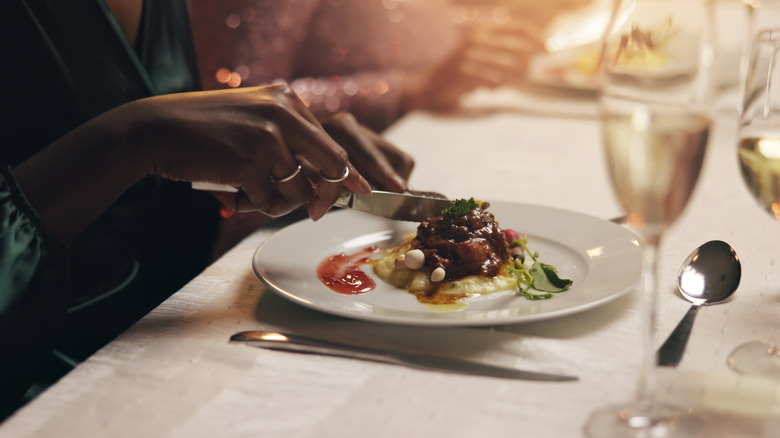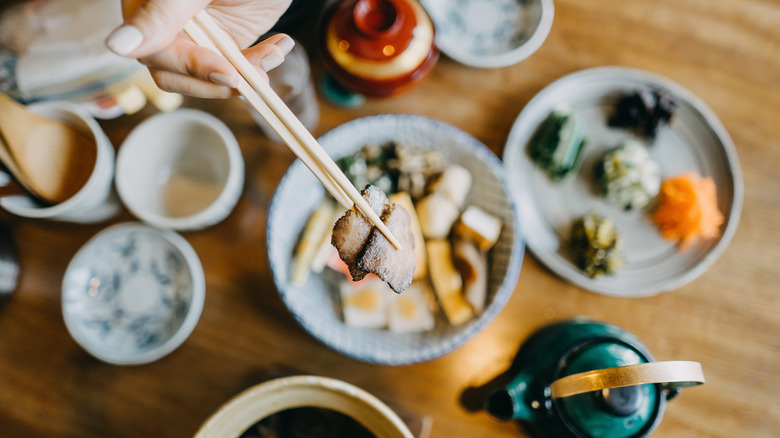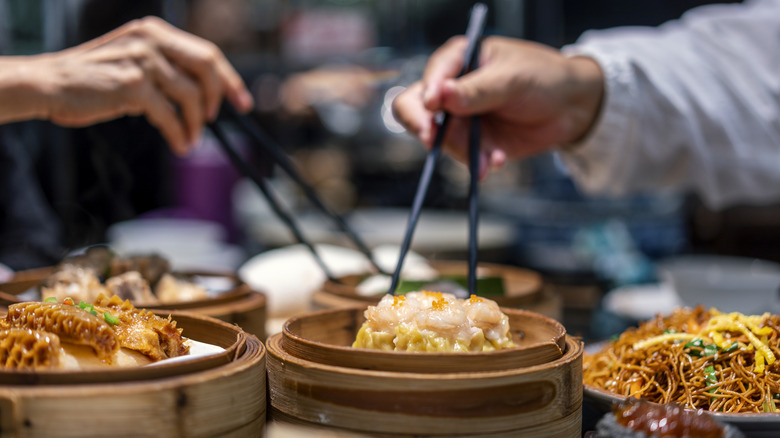How 4 Different Parts Of The World Indicate When A Meal Is Finished
In the West, there are a lot of rules when it comes to dining out. Basic manners like keeping your elbows off the table (which dates back to the Medieval period) and taking off your hat are just a few of the well-known ways to show off good etiquette — but there are many other little-known rules for fine dining if you really want to display your pedigree.
Around the world, however, the customs are different, including when it comes to indicating when lunch or dinner is finished. Food Republic asked etiquette expert and author of "Going Public," Nikesha Tannehill Tyson of The Swann School of Protocol in Shreveport, Louisiana what some of the differences are for ending a meal in places like the USA, Western Europe, Japan, and China, and we were surprised to find that what's proper in one country can often be the total opposite in another.
"Cultural etiquette for signaling the end of a meal varies widely across the globe," said Tannehill Tyson. "Understanding these nuances can help you navigate international dining with ease and respect." No matter where you go, Tannehill Tyson noted that you should keep your eye on the host for cues about dining rules. If you're not sure about something, it's okay to ask a thoughtful question, and it's definitely a good idea to do a little research on cultural practices before the meal. "A bit of cultural awareness goes a long way in making a positive impression and enjoying the meal with elegance and poise."
How to signal you're done in the United States and Western Europe
Even if you grew up in the United States or Western Europe, not everyone knows the proper way to signal, "I'm done eating" when they've finished a meal. The etiquette rules for Western culture have been around for a long time, however, so if you don't know the correct way to end your meal when you're dining out, Nikesha Tannehill Tyson has the answer. The universally accepted sign is given by placing your silverware on the plate a certain way.
"Place the fork and knife parallel on your plate with the handles at the 4 o'clock position to indicate you're finished," she said, adding, "A loosely folded napkin placed to the left of your plate also signals the end of the meal."
In France, where fine dining is baked into the culture, Tannehill Tyson said to again place your utensils parallel on the plate when you're done. Also, definitely avoid stacking any empty plates. "This is the host or server's role," she sagely noted. After all, your server has a method for clearing that you may have interfered with, even if you mean well.
Proper dining etiquette in Japan
The end of a meal is a different story when you're dining in Japan — indeed, etiquette in general is quite different than in the West. For example, it's considered polite to slurp in Japan to demonstrate just how much you enjoy your meal. You may also be surprised to learn that it's not always polite to eat sushi with chopsticks either.
Additionally, your server or host is on the lookout for an empty plate, said expert Nikesha Tannehill Tyson. "Finishing everything on your plate is a way to show appreciation for the meal," she noted of Japanese culture. "When using chopsticks, place them neatly on the chopstick rest." And don't worry about being too full to finish. In Japan, you're given small portions of a diverse group of foods, ensuring you get enough but not too much.
China has different etiquette entirely
If you find yourself out to dinner in China, or at a meal hosted by Chinese friends, Nikesha Tannehill Tyson said that it's good manners to avoid completely cleaning your plate. "Leaving a small amount of food on your plate is polite and shows you're satisfied," she stated. "Avoid cleaning your plate entirely, as this might suggest the host didn't serve enough."
You'll also likely have two sets of chopsticks — one for serving yourself from communal dishes, and another set entirely for eating off your plate. This way, you avoid cross-contamination. When serving yourself, don't stab or rip the food, and only get one dish as a time, so you can really enjoy the flavor of each.




